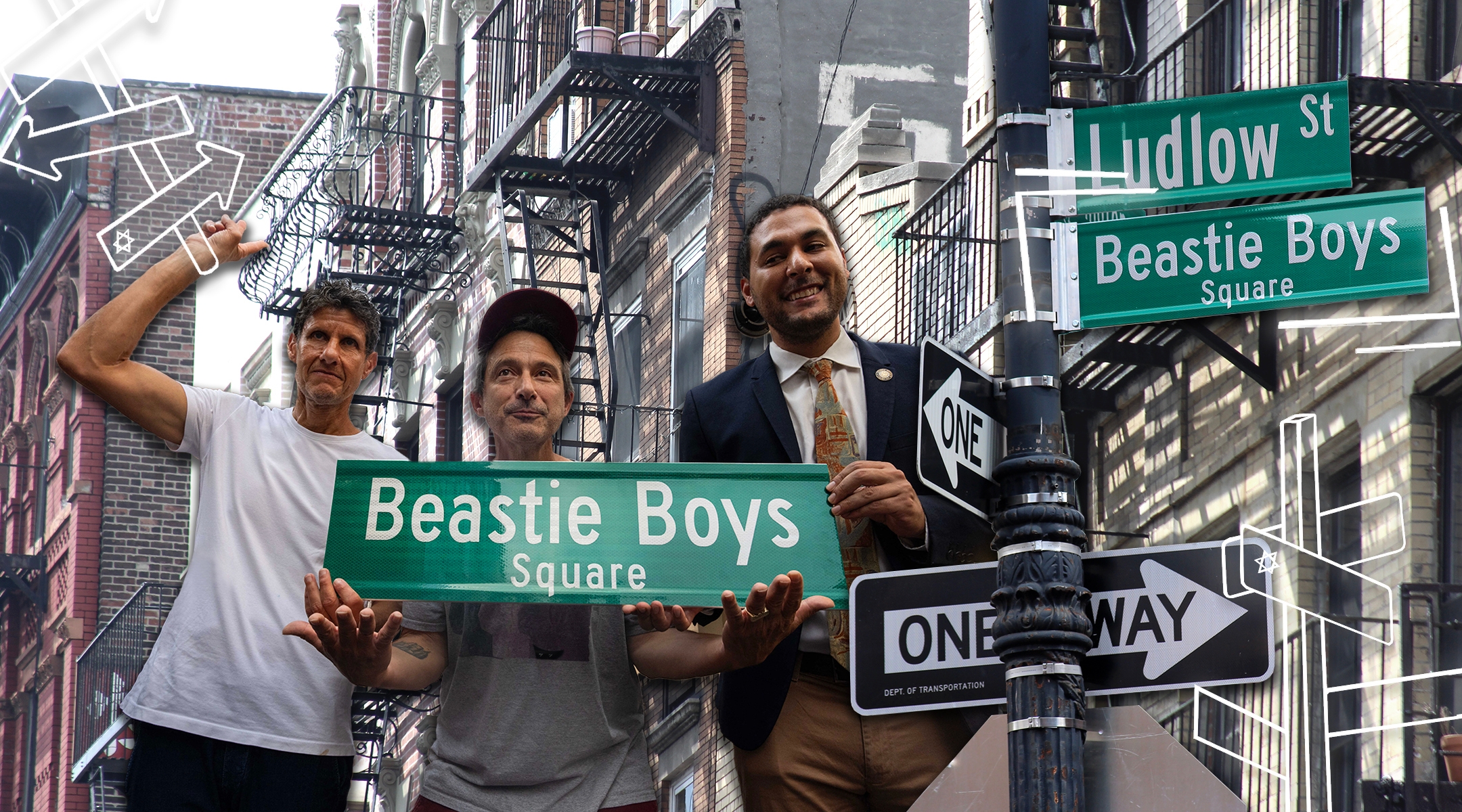(New York Jewish Week) — The corner of Ludlow and Rivington streets in New York City is now officially known as Beastie Boys Square.
The co-naming of this Lower East Side street corner — where the shop featured on the Jewish rappers’ second album, “Paul’s Boutique,” once stood — was the result of a 10-year effort spearheaded by Leroy McCarthy, an activist who has successfully lobbied for other New York City streets named in honor of rappers, including Notorious B.I.G. and the Wu-Tang Clan.
Hundreds of New Yorkers packed the downtown intersection Saturday afternoon for the official unveiling of Beastie Boys Square. Though some kvetched about the humidity and the unexplained 80-minute delay, the Gen X-heavy crowd — plus a smattering of their offspring — was a respectful one, singing along to years’ worth of Beastie Boys songs played on loudspeakers as they waited for the ceremony to begin, and for the appearance of the two people everyone had come to see: Adam “Ad-Rock” Horovitz and Michael “Mike D” Diamond.
Horowitz, Diamond and Adam “MCA” Yauch, who died in 2012 at 47, formed their highly influential band in New York City in 1981. Though they started as a teenage punk band, they eventually pivoted to hip-hop — and after their first rap album — 1986’s “Licensed to Ill,” produced by fellow Jewish hip-hop fan Rick Rubin — produced a series of hits, the Beastie Boys became household names.
The group followed up with 1989’s sample-heavy “Paul’s Boutique” — featuring the photograph of the Lower East Side street corner — which flopped upon its release but is now widely considered a masterpiece. Their next albums, 1992’s “Check Your Head” and 1994’s “Ill Communication” were cultural juggernauts, and four more albums followed.
All three Beastie Boys have Jewish backgrounds: Horovitz, 56, grew up on Park Avenue, the son of playwright Israel Horovitz and a Roman Catholic mother. Diamond, 57, grew up on the Upper West Side; his father, Harold, was an art dealer and his mother, Hester, was a famous decorator and art collector. Yauch hailed from Brooklyn Heights, the only child of Frances, a Jewish social worker, and a non-Jewish architect.
In 2004, the group gave a very Jewish interview with Heeb magazine, in which Yauch disclosed he was trying to get his Uncle Freddy to teach him some Yiddish “so I could work some Yiddish lyrics on an album.” Diamond said he was raised by “a Barney Greengrass family,” referring to the famous Upper West Side appetizing shop.
Following Yauch’s death from cancer, the group disbanded. So, on Saturday, anticipation crept up alongside the mercury in the thermometer as the crowd waited to catch a glimpse of the remaining Beasties.
But first, local politicians had things to say. Kicking off the speeches with a “mic check” or two was Manhattan Borough President Mark Levine, who put the Beasties’ Jewishness front and center.
“I was 16 when ‘Licensed to Ill’ came out — it was like a thunderbolt came down and struck me,” he said. “Now, I know these guys didn’t advertise it, but trust me: Every Jewish kid in America, we knew they were Diamond and Yauch and Horowitz.”
“Were you a Jewish kid in America back in the 80s and 90s?” Levine shouted to the crowd, and many — including this reporter — cheered back. “Yes you were! Personally, that was the first moment I realized there was maybe a faint hope that I could be cool. It didn’t work out, but I still have hope.”
As it happens, the Beasties have a few Jewish lyrics in their stable, including biblical references, a shoutout to Ellis Island, and Ad-Rock’s line “Well I’m a funky-ass Jew and I’m on my way/ And yes I got to say f— the KKK” on “Right Right Now Now” from the 2004 album “To the 5 Boroughs.”
Three other local politicians spoke: Assembly member Grace Lee and City Council members Carlina Rivera and Christopher Marte, the last of whom Levine credited with making Beastie Boys Square happen.
“You have no idea how hard it is to get a street renamed in New York,” Levine said of Marte. “He did it.”
The activist McCarthy’s initial proposal for Beastie Boys Square was rejected by Community Board 3 in 2014 because the name change didn’t meet requirements. McCarthy was subsequently barred from reapplying for the name change for another five years. His renewed proposal was approved in 2022 with the support of Marte and other local politicians. In 2013, a small Brooklyn playground was named for Yauch.
At last, it was time for the main event, and Horovitz and Diamond took to the stage while the crowd cheered. Horovitz, who said he “brought notes,” spoke first, exclaiming that he didn’t realize other people would be speaking. “Sorry if I’m saying what they said,” he said, thanking McCarthy and “everyone who loves Beastie Boys music.”
“I don’t really understand why, but I know that I love it, so in a way that makes us kind of friends, right?” he added. “Like we bonded over these weird records, so thank you.”
He also thanked New York City, not only for the street renaming, but “for teaching us what to look at, what to listen to, what to wear, how to love, how to live.”
Next, Diamond took the mic, thanking the crowd for coming despite the heat. “Everyone is so dedicated, willing to put in the work to show the love, not only for this band, but, I think, everything we came from, coming from New York City.”
After giving a shoutout to his deceased parents, Diamond also expressed his love for New York, saying that the Beastie Boys couldn’t have come from anywhere else. “Growing up here in New York City and hearing all this incredible music, being all this incredible art, being around all these incredible people — this only in New York City,” he said. “So thank you so much, y’all.”
He concluded his remarks with moving words for Yauch, whom he described as their “brother on this amazing journey.” The crowd responded with chants of “MCA! MCA!”
But Horowitz, who appeared to get a bit verklempt as he concluded his speech, arguably summed up the meaning of the event best.
“We walk around these streets and we don’t really think about who they’re named after, like Ludlow Street, Irving Street, Father Demo Square,” he said. “But it makes me really happy to know that some kid on their way to school 50 years from now is gonna pass by this and look up and be like, ‘What the f— is a Beastie Boy and why do they have a square?’ Just like I did when I was a kid, looking at Perry Street, Charles Street, wondering what it’s about.”
If you’re like Ad-Rock and your curiosity is piqued, don’t miss the other stories in our Sign Post series, which delves into other city streets named after New York Jews. Check-ch-check-check-check-ch-check it out!
The New York Jewish Week brings you the stories behind the headlines, keeping you connected to Jewish life in New York. Help sustain the reporting you trust by donating today.





